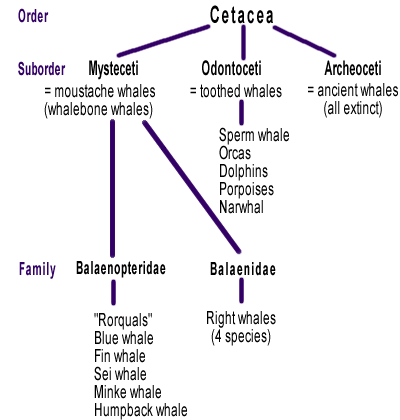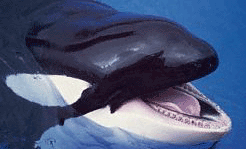Whales are amongst the most enigmatic and fascinating of all creatures. The Blue Whale is the largest animal ever to have lived on earth, at up to 100 tons, easily out-weighing the heaviest dinosaurs, even an "ordinary " sized whale is a vast and impressive creature.
Whales are huge, but elusive and difficult to see which adds to their mystery and fascination. They are highly intelligent animals with an elaborate social life, no possessions and the complete freedom of movement in three dimensions. Is it any wonder that they are such popular and fascinating animals? - maybe we just want to be like them!
Whales belong to the group of mammals called Cetaceans, they are a part of this group along with dolphins and porpoises.
Whales are mammals as are humans, dogs, cats, elephants and anguantibos amongst others. This means that they are not fish. They breath air and so must return to the surface at regular intervals to get a breath. They give birth to live young that stay with the mother for over a year and feed on milk produced by the mother.
Whales are warm blooded and have a skeleton similar to our own (though greatly modified) the fore limbs are their front flippers and have similar bones in them to our arms and hands. The hind-limbs are generally not present at all, though are represented in many species by a tiny pair of "free floating" bones (pelvic vestiges) - not attached to any others - towards the rear of the animal. In the males of some species these bones serve as an insertion for the muscles that control the penis.
The rear flippers of a whale are called the flukes, these have no bone in them at all, being made of tough fibrous material. It is the flukes that provide the propulsive power in all Cetaceans with the forelimbs controlling direction and being used for communicative and social functions.
All whales have muscle with a high level of Myoglobin. This is a red pigment similar to haemoglobin that stores oxygen in the muscles for use during deep dives. When the whale surfaces, the oxygen in the myoglobin is replaced, similar to the process that happens in our own muscles during a sprint.
| Toothed whales or Baleen whales |
Cetaceans are split into two groups, depending on whether they have teeth or not.
Toothed whales - Odontoceti
This group includes Dolphins, Porpoises, Killer whales (Orcas) and Sperm Whales. They have teeth in the usual manner, usually consisting of lots of identical peg-like (but often very sharp!) teeth to catch their slippery prey. Odontocetes are predators on fish or other fast swimming and fairly large prey such as squid. Toothed whales differ from baleen whales (and every other mammal) in that they only have one nostril instead of two.
A young Killer Whale - Orca showing teeth. Orcas have teeth in both jaws like most Odontoceti, Sperm Whales are unusual in that they only have teeth in the lower jaw.
Baleen Whales - Mysticeti
The members of this group don't have teeth as we know them, but baleen plates or "whalebone". The whole skull of such whales is highly modified. There is a large strong bony projection from the front of the "brain case" from which baleen plates (made of keratin, like skin, fingernails, hair, hooves and rhino horns) hang on either side. This makes a triangular tent-like structure that is a large and elaborate sieve. The lower jaw is the "floor" of this tent and baleen whales have a huge tongue that sits in the middle of it all.
Mysticetes take in a mouth full of sea water and huge numbers of planktonic food such as krill or even shoaling fish They then close their mouths and use the tongue to push out all of the water through the baleen filters which keep the small prey inside, these are then swallowed. Different species of whales feed on different sizes of prey according to how wide the gaps in their baleen filters are. In this way, they don't all compete directly with each other and so are able to co-exist in the oceans occupying different "niches".
A Right Whale, a baleen whale, showing the baleen in the mouth and the large tongue
The baleen whales include all the really large whales apart from the Sperm Whale (which has teeth). Blue, Right, Sei, Fin, Gray and Minke whales are all baleen whales.
Sometimes whales may be referred to as "Rorquals" These are members of a group of whales that are characterised by having numerous longitudinal grooves along the throat region, they also have short baleen plates, rarely more than 3 feet long and are the fastest swimming of the whales.
| Taxonomy of whales |
Taxonomy is the study of the relationships between organisms. It is a system of classifying them by observable structures that may be large, molecular or anywhere in between. Taxonomy groups organisms according to their similarities based on evolutionary relationships.
Whales are mammals of the order Cetacea:

This is not a comprehensive summary of the taxonomy of all Cetaceans, but of those found commonly in Antarctica and covered in more detail on this site.
It's always struck me how there's not that many pictures of whales around and the ones that there are often not really that clear. The reason for this is that it's very difficult to take a picture of something so large that lives in the water. It's not helped by the fact that whales while being very large are also pretty fast swimming and difficult to find in the vast expanses of ocean.
Their size means that you need to be quite a distance from the whale in order to take a picture, many waters are not that clear and by the time you're 100-150 feet away to get the whole whale in the picture, you just can't see it very well any more!
Open oceans tend to be clearer than coastal waters, but then there's the problem of finding the whales, once you know where they are you need to get to them, usually by boat which in the process will probably scare them away. Sure you can find and follow whales in fast boats like the whalers used to do, but the cost is to terrify the poor creature in the process and by the time you've jumped in the water to take some pictures, you've been left way behind and are now able only to swim at a snails pace compared to the full speed whale.
The final problem - though really part of the other two - is that no-one knows where whales spend much of the year. We know where they go to feed during seasonal abundances of foods when the problem is usually that the plankton in the water that is the reason for the whales being there make it difficult to see far under water, and a hungry whale swimming around feeding happily is a difficult thing to get near and get to pose for you.
The end result of all this is that good pictures of any whales are difficult to achieve and any pictures of some whales are almost impossible to achieve. So most of what there are tend to be of a few easier to photograph species such as Humpbacks and Orcas, or of bits of the whales as seen from the surface usually headed in the other direction.



